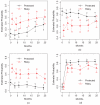Trajectories of risk behaviors and exiting homelessness among newly homeless adolescents
- PMID: 21494426
- PMCID: PMC3075065
- DOI: 10.1080/17450120902884068
Trajectories of risk behaviors and exiting homelessness among newly homeless adolescents
Abstract
Using cluster analysis techniques, we identified two distinct clusters of newly homeless adolescents in Los Angeles (n = 261): those who are protected and doing relatively well while out of home with more protective than risk factors, and those who are risky with more risk than protective factors. The objective of this study was to examine the trajectories of human immunodeficiency virus (HIV) risk behaviors and exiting homelessness among protected newly homeless adolescents, compared to those who are classified as risky. HIV risk behavior included unprotected sex, having multiple sex partners and hard drug use. Logistic regression mixed-effects models were used to evaluate the trajectories of HIV risk behaviors and exiting homelessness over time. The adolescents in the protected group reported significantly less unprotected sex ( p = 0.0156), being abstinent or monogamous ( p < 0.0001) and less hard drug use ( p < 0.0001) compared to the adolescents in the risky group. In addition, the protected group reported more "exiting homelessness", compared to the risky group ( p = 0.0007). However, the differences in the level of unprotected sex between the protected and risky groups decreased over time. Our findings confirm the notion that newly homeless adolescents are indeed heterogeneous. Given that the risk behavior profiles of protected group merges to the risky group over time, our findings underscore the need to mount tailored interventions to be designed for the protected group early in the process.
Figures
Similar articles
-
WHO IS DOING WELL? A TYPOLOGY OF NEWLY HOMELESS ADOLESCENTS.J Community Psychol. 2009 Jan 29;37(2):135-147. doi: 10.1002/jcop.20283. J Community Psychol. 2009. PMID: 20174594 Free PMC article.
-
Adolescents Exiting Homelessness Over Two Years: The Risk Amplification and Abatement Model.J Res Adolesc. 2009 Dec 1;19(4):762-785. doi: 10.1111/j.1532-7795.2009.00610.x. J Res Adolesc. 2009. PMID: 25067896 Free PMC article.
-
Homelessness experiences, sexual orientation, and sexual risk taking among high school students in Los Angeles.J Adolesc Health. 2013 Jun;52(6):773-8. doi: 10.1016/j.jadohealth.2012.11.011. Epub 2013 Jan 27. J Adolesc Health. 2013. PMID: 23360897 Free PMC article.
-
Individual-Level Predictors for Becoming Homeless and Exiting Homelessness: a Systematic Review and Meta-analysis.J Urban Health. 2019 Oct;96(5):741-750. doi: 10.1007/s11524-019-00377-x. J Urban Health. 2019. PMID: 31388823 Free PMC article.
-
Behavioral Counseling Interventions to Prevent Sexually Transmitted Infections: A Systematic Evidence Review for the U.S. Preventive Services Task Force [Internet].Rockville (MD): Agency for Healthcare Research and Quality (US); 2020 Aug. Report No.: 19-05260-EF-1. Rockville (MD): Agency for Healthcare Research and Quality (US); 2020 Aug. Report No.: 19-05260-EF-1. PMID: 32970399 Free Books & Documents. Review.
Cited by
-
Resiliency and survival skills among newly homeless adolescents: Implications for future interventions.Vulnerable Child Youth Stud. 2011;6(4):301-308. doi: 10.1080/17450128.2011.626468. Vulnerable Child Youth Stud. 2011. PMID: 22216061 Free PMC article.
-
Text-Messaging, Online Peer Support Group, and Coaching Strategies to Optimize the HIV Prevention Continuum for Youth: Protocol for a Randomized Controlled Trial.JMIR Res Protoc. 2019 Aug 9;8(8):e11165. doi: 10.2196/11165. JMIR Res Protoc. 2019. PMID: 31400109 Free PMC article.
-
Impact of nursing intervention on improving HIV, hepatitis knowledge and mental health among homeless young adults.Community Ment Health J. 2013 Apr;49(2):178-84. doi: 10.1007/s10597-012-9524-z. Epub 2012 Jul 15. Community Ment Health J. 2013. PMID: 22797748 Free PMC article. Clinical Trial.
References
-
- Beardslee WR. Self-understanding and coping with cancer. In: Koocher G, O’Malley J, editors. The Damocles syndrome: Psychosocial consequences of surviving childhood cancer. McGraw-Hill; New York: 1981. pp. 144–163.
-
- Beardslee WR, Keller MB, Lavori PW, Staley JE, Sacks N. The impact of parental; affective disorder on depression in offspring: A longitudinal follow-up in a non-referred sample. Journal of the American Academy of Child and Adolescent Psychiatry. 1993;37:1134–1141. - PubMed
-
- Compas BE, Worsham NL, Ey S, Howell DC. When mom or dad has cancer: II. Coping, cognitive appraisals, and psychological distress in children of cancer patients. Health Psychology. 1996;15:167–175. - PubMed
-
- Ensign J, Santelli J. Health status and service use: Comparison of adolescents at a school-based health clinic with homeless adolescents. Archives of Pediatric Adolescent Medicine. 1998;152:20–23. - PubMed
-
- Farrow JA, Deisher RW, Brown R, Kulig JW, Kipke MD. Health and health needs of homeless and runaway youth. Journal of Adolescent Health. 1992;13:717–726. - PubMed
Grants and funding
LinkOut - more resources
Full Text Sources
Medical

